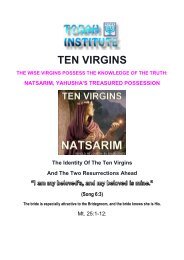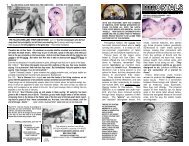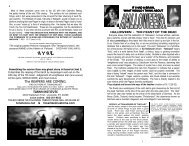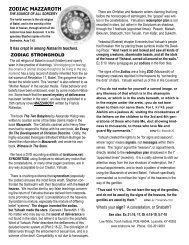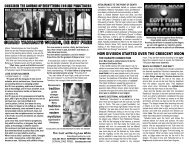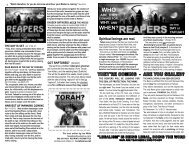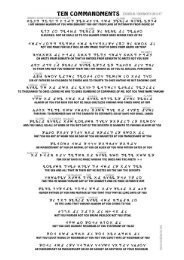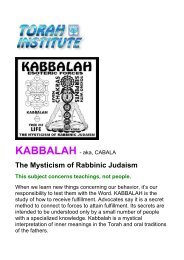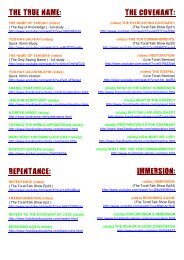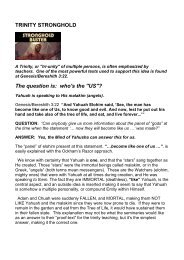PARTING OF WAYS - HOW ONE FAITH BECAME TWO
This article explains how the faith of Abraham and the true way diverged into a more gentile fusion-religion. It all began after 70 CE, and a tax levied against those who observed Torah.
This article explains how the faith of Abraham and the true way diverged into a more gentile fusion-religion. It all began after 70 CE, and a tax levied against those who observed Torah.
You also want an ePaper? Increase the reach of your titles
YUMPU automatically turns print PDFs into web optimized ePapers that Google loves.
4<br />
MONUMENTS BUILT WITH THE WEALTH <strong>OF</strong> YERUSHALAYIM:<br />
ROMAN COLOSSEUM<br />
<strong>HOW</strong> <strong>ONE</strong> <strong>FAITH</strong> <strong>BECAME</strong> <strong>TWO</strong><br />
Paul realized distortions were coming.<br />
From Miletos, Paul called the elders of Ephesus to<br />
meet together. This is what he told them:<br />
“Therefore take heed to yourselves and to all the<br />
flock, among which the Ruach ha’Qodesh has<br />
made you overseers, to shepherd the assembly of<br />
Alahim which He has purchased with His own<br />
blood. For I know this, that after my departure<br />
savage wolves shall come in among you, not<br />
sparing the flock.<br />
Also from among yourselves men shall arise,<br />
speaking distorted teachings, to draw away the<br />
talmidim after themselves.” Acts 20:28-30 BYNV<br />
Paul’s former assignment, when known as Shaul,<br />
was to arrest those in the congregations who pronounced<br />
the Name aloud. This was forbidden, and<br />
carried the death penalty, since uttering “Yahuah”<br />
was considered “blasphemy”. He watched the<br />
robes of the men that stoned Stephen (Acts 7).<br />
After meeting Yahusha on the road to Damascus,<br />
Paul was proclaiming the true Name, and teaching<br />
about Yahusha. Having been arrested, Paul was<br />
confronted by the accusations of Tertullus before<br />
Felix: “For having found this man a plague,<br />
who srs up dissension among all the Yahudim<br />
throughout the world, and a ringleader<br />
of the sect of the Natsarim . . ,” Acts 24:5.<br />
Later in this chapter, Paul claims to worship according<br />
to all that is written in the Torah and the<br />
Prophets. In other words, Paul’s way of life was<br />
nothing like modern Christianity. He was a<br />
“Natsarim”, and obeyed the Commandments. The<br />
7th day of the week was still Shabath to him. Paul<br />
would not have been shocked about “Sun-day”,<br />
because he knew savage wolves would later come<br />
teaching distortions. As savage wolves, they focus<br />
on collecting “the tithe”, yet forsake teaching Torah.<br />
We are witnesses of these distorted teachings, and<br />
as Yahusha’s Natsarim we overthrow them with<br />
Truth, in love.<br />
The doctrine one lives by may come from one of two<br />
sources: Scripture (Yahuah’s inspired instructions), or<br />
men’s traditions. Looking around this world, and listening<br />
to what is normally taught, it is highly unlikely most<br />
people live by what Scripture shows us as pleasing<br />
behavior before Yahuah.<br />
Most of our traditions come from pagan sources.<br />
All of these were inherited from pagans:<br />
Sun-day assemblies, statues, rosaries, holy water,<br />
Easter baskets (in place of Passover and First-fruits),<br />
Christmas, wreath and tree-decorating, eating swine,<br />
sunrise “services”, and praying in circles. Another huge<br />
stronghold is how everyone is using a false name in<br />
place of the true identity of our Deliverer. There is only<br />
one name given among men for deliverance.<br />
(see Acts 4:12). His Name is Hebrew.<br />
The Name is the Stone which the builders rejected<br />
(see Psalm, 118). YashaYahu 52:6 tells us Yahuah’s<br />
people will know His Name, Yah Al (Joel) 2 quoted by<br />
Kefa tells us those calling on it will be delivered, and<br />
Acts 4:12 tells us there is one Name.<br />
The Name and the Word are above all else (Ps 138:2),<br />
and we Natsarim are the guardians of the Name, and<br />
the Word, of Yahuah. What was whispered in the inner<br />
rooms is being shouted from the rooftops. If the Torah<br />
of Mosheh is what we are told to “remember” before<br />
the Day of Yahuah comes, then that’s what we should<br />
be telling everyone (Mal. 4:4-6).<br />
Billions have never even heard the word “Torah” in<br />
their lives, and yet they support men to teach them the<br />
way of deliverance. Come out of her, My people!<br />
Repent, for the Reign of Yahuah is near!<br />
This article by brother Lew White<br />
TORAH INSTITUTE<br />
PO BOX 436044, Louisville, KY 40253<br />
fossilizedcustoms.com<br />
502-261-9833 REPRINTS PERMITTED<br />
DOWNLOAD FREE: torahzone.net<br />
FISCUS IUDAICUS<br />
The fiscus Iudaicus (Latin for "Jewish tax") or<br />
fiscus Judaicus was a tax-collecting directive<br />
instituted to collect the tax imposed by emperor<br />
Vespasian on Yahudim (Ioudaios/Jews) over all<br />
the Roman Empire after the destruction of<br />
Yerushalaim and its Temple in 70 CE. Revenues<br />
were directed to support the Temple of Jupiter<br />
Optimus Maximus in Rome.<br />
Persons who behaved like Yahudim, or met with<br />
them to study Torah-observance, whether or not<br />
they were believers in Yahusha, were taxed. This<br />
tax usurped the tithe that was originally sent to<br />
support the Temple. It was redirected to lavishly<br />
support the pagan Roman religious institutions.<br />
The only way to be exempt: abandon Yahudaism.<br />
YAHUDAISM TO CHRISTIANITY<br />
Before the Temple was destroyed in 70 CE, there<br />
was no separation whatsoever between those<br />
who believed Yahusha is the Mashiak from those<br />
who did not. Luke’s 2nd writing, Acts, is a record<br />
spanning about 30 years. It was written between<br />
60-62 CE, during the horrific reign of Nero. The<br />
emperor Claudius had expelled all Yahudim from<br />
Rome in 49 CE, and we know Aquila and Priscilla<br />
were of those expelled. Paul met with them at<br />
Corinth: Act 18:2 “And he found a certain Yahudi<br />
named Aquila, born in Pontos, who had recently<br />
come from Italy with his wife Priscilla, because<br />
Even before the destruction of Yerushalayim, Rome<br />
was watching those who would not worship their<br />
emperors and pay homage to their deities. For this,<br />
the Yahudim already had their attention.<br />
To the Romans, those who believed in Yahusha were<br />
a part of the same body of people because they<br />
observed Torah in exactly the same way, and met<br />
with one another. There are three perspectives; that<br />
of the pagan Roman magisterium, the Yahudim who<br />
observed Torah and the traditions of the fathers, and<br />
the new third group among them, the Natsarim. The<br />
Natsarim consisted of both former gentiles as well as<br />
those of the natural branches of Yisharal. Because of<br />
VESPASIAN CAPTIVITY COIN<br />
Tax Pressure Caused A Schism<br />
After Second Temple Period<br />
Claudius had commanded all the Yahudim to<br />
leave Rome – and he came to them.”<br />
About 3 years before Paul wrote the letter to<br />
the Romans, Nero lifted the edict of Claudius,<br />
so Yahudim were permitted to live at Rome<br />
again. Even in the late 50’s when Paul wrote<br />
to the Romans, there was no separation or<br />
parting between believers in Yahusha and<br />
those who met together without believing.<br />
Luke recorded Acts only a few years prior to<br />
the destruction of Yerushalayim. After the year<br />
70, the pressure of taxation on anyone that<br />
observed Torah became a factor in developing<br />
new behavioral patterns and terminology.<br />
Because the Roman tax agency was watching<br />
closely, gentile converts felt they did not owe<br />
the fiscus Iudaiscus, so they slowly withdrew<br />
and met separately. To appear distinguished,<br />
they made as many changes as possible.<br />
the fiscus Iudaicus, those of the formerly gentile<br />
faction contemplated how they were different, and<br />
should be treated as distinct by those imposing the<br />
tax. This distinction didn’t matter at all, since they<br />
behaved exactly the same even if they did meet<br />
separately from the main congregation they had<br />
once been a part of. We see this even today, as<br />
congregations split apart for one reason or another.<br />
With the annoyance of taxation, and being aware<br />
the tribute was used to support the pagan magisterium,<br />
a gradual shift began to take place as more<br />
converts entered the fold.<br />
The average pagan Roman citizen was living in a
2<br />
MYSTAGOGUE:<br />
PERSON WHO INITIATES IN MYSTERIES<br />
world that worshipped Mithras. Their meetings<br />
took place in caverns or rooms built to resemble<br />
caverns, with an indoor altar at one end of the<br />
space. The initiates progressed through grades<br />
or levels, similar to the method seen today in<br />
Masonry. More Mithraic mysteries were revealed<br />
as the adherent progressed to higher grades.<br />
A “mystagogue” explained the mysteries and<br />
theology to the initiate.<br />
Very early, unconverted pagans became joined<br />
to the body of true believers, just as we see in<br />
groups today. As more converts from the pagan<br />
world entered into the congregations of those<br />
motivated to avoid paying the fiscus Iudaiscus,<br />
the more the behavior and surroundings took on<br />
their manner. Aspects such as steeples, icons,<br />
genuflecting, holy water, indoor altars, haloes, or<br />
statues were never part of the culture of Yisharal.<br />
To a Roman taxing official, the appearance of the<br />
“new Christian” assembly would have been mostly<br />
like the Mithras worshippers. The worshippers<br />
of Serapis at Alexandria were called “Christians”,<br />
so adopting this label helped shield the nowcorrupted<br />
followers of Yahusha from appearing to<br />
be “Jewish”. Adopting all the accessories and<br />
gimmickry of the pagans, the new group could<br />
attract far greater numbers from the general<br />
population. The ignorant masses of pagans used<br />
the symbol of the crux widely as a symbol for the<br />
sun, and so by the time of Constantine it became<br />
adopted to link “Christ” with “Apollo”, Constantine’s<br />
most favored deity. As the dirty snowball<br />
grew larger, the Latin language translation by<br />
Eusebius Sophronius Hieronymus (Jerome) brought<br />
the term crux into the text, avoiding the word stauro,<br />
the Latin equivalent to the Greek stauros. Now, the<br />
new faith even had a logo, the former symbol of sun<br />
worship: the solar cross.<br />
Lawrence Schiffman (Yeshiva University) writes:<br />
“The split between Judaism and Christianity did not<br />
come about simply or quickly. . . Further, the question<br />
of legal status as seen through Roman eyes<br />
also had some relationship to the issue.”<br />
“The Romans at first regarded the Christians as<br />
part of the Jewish people. When Christianity spread<br />
and took on a clearly different identity, as acknowledged<br />
by both Jews and Christians, the Roman<br />
government modified its view. The emperor Nerva<br />
(96–98 C.E.) freed the Christians (probably including<br />
the Jewish Christians) from paying the fiscus<br />
judaicus, the Jewish capitation tax decreed as a<br />
punishment in the aftermath of the revolt of 66–73<br />
C.E. Clearly, the Romans now regarded the Christians<br />
as a separate group. The way was paved for<br />
the legitimization of Christianity as a licit religion.<br />
The decline of the old pagan cults, coupled with the<br />
tremendous success of Christianity, would eventually<br />
lead to the acceptance of the new faith as the<br />
official religion of the Roman Empire in 324 C.E.”<br />
Lawrence H. Schiffman, From Text to Tradition,<br />
Ktav Publishing House, Hoboken, NJ, 1991.<br />
Because the taxing authorities were constantly<br />
snooping around, it was advantageous to appear<br />
and sound completely distinct in every way. Trying<br />
to appear different, the Hebrew roots of the faith<br />
were masked as much as possible, so changing<br />
terms and altering names became acceptable.<br />
The Greek texts eliminated the Name, and put in its<br />
place a code, in case a snooping tax agent were to<br />
examine them. In place of the Name Yahusha, a<br />
secretive “Christogram” was used, which could only<br />
be understood through a mystagogue. The "IY" (IU)<br />
in Greek manuscripts is an encoded "christogram",<br />
usually with a bar over the letters (a titlos, meaning<br />
"title"), a substitution for the Name of Yahusha.<br />
IC XC, IHS, and later Chi-Rho and IXTHUS, were<br />
Constantine confused<br />
Yahusha with Apollo,<br />
his sun deity.<br />
NAME ENCODED IN “CHRISTOGRAMS”<br />
LATIN CHRISTOGRAMS<br />
IN THE GREEK COPIES<br />
Tampering with Greek scripts, monks/mystagogues<br />
omitted the Mashiak’s Name in their copies.<br />
They adopted the altered form for Yahusha, IHSOUS,<br />
from the Greek spelling in the Septuagint.<br />
The 1st and last letters of IHSOUS XRISTOS, IOTA-<br />
SIGMA & CHI-SIGMA, were placed into the Greek<br />
copies with Latin letters, IC XC. They mixed Latin<br />
letters with the Greek, leaving their Latin fingerprints<br />
behind. The Greek letter SIGMA is represented as the<br />
letter “C” in Latin. Because the word for “fish” in Greek<br />
begins and ends with IOTA & SIGMA, the word<br />
IXTHUS was turned into an acronym to further<br />
“mystify” initiates with their mystagoguery.<br />
used to conceal the Name.<br />
The “congregations” described in the Natsarim Writings<br />
are often described by the Greek term<br />
“synagogues”, and were not buildings. Even the<br />
term “synagogue” helped to make them seem more<br />
“gentile”, since the word is Greek. The Hebrew term<br />
SHUL was avoided. The group may have met in a<br />
room, or other place such as Luke described at Acts<br />
16:13 - by a river. The word “church” originally was<br />
a pagan word describing a place of worship. It is<br />
seen as kerk, kirk, kirke, circe, circus, cirice. Tyndale<br />
used it only twice (Acts 14:13, 19:37) to describe the<br />
pagan houses of worship. He was burned at the<br />
stake by Henry VIII for his translation, since church<br />
referred to the authority (hierarchy) over the laity.<br />
Tyndale used the word “congregation”, making all<br />
members of the body on the same level.<br />
DIVISIONS - LACK <strong>OF</strong> UNITY<br />
Read Acts 17. Paul goes to the Yahudi assemblies,<br />
on a day Luke refers to as “the Shabath”. The noble<br />
“Bereans” checked Scripture to see if the things Paul<br />
said were true. They were not “Christians”, and<br />
never became Sun-day observers that ate pigs. Paul<br />
claimed he was a “Pharisee”, meaning he was<br />
brought up in the discipline of the Prushim, one of<br />
the strictest sects of them all. After his conversion,<br />
Paul was given a new perspective, and unity of the<br />
belief in Yahusha’s deliverance was his aim; he did<br />
not teach against Torah, but established it.<br />
1Co 1:10: “And I appeal to you, brothers, by the<br />
Name of our Master Yahusha Mashiak, that you all<br />
agree, and that there be no divisions among you,<br />
but that you be knit together in the same mind and in<br />
the same opinion.” Paul saw Kefa behaving oddly<br />
around other Yahudim when eating with converts<br />
from the gentiles, and exposed such hypocrisy to his<br />
face (Gal. 2).<br />
The wealth taken away by the Romans under<br />
Titus and his father Vespasian was used to build<br />
the Roman Colosseum, and build two arches,<br />
one for Titus, and one for Vespasian. The arch<br />
of Titus still remains, and this photo inside the<br />
arch celebrates one of the saddest days for<br />
Yerushalayim, which Yahusha foretold.<br />
3




